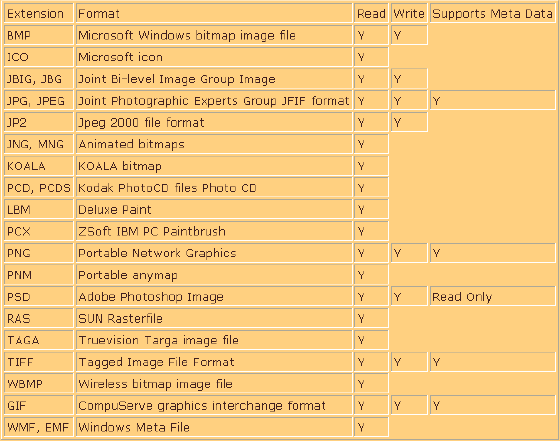|
ImageWalker 2.20 - User Guide and FAQ
Screenshots - More Details
What image formats are supported by ImageWalker?
The following table lists the various file formats that ImageWalker can process. The 'Supports Meta Data' column shows if description information can be stored in an image.

Image Walker also supports various media files. Displaying of these media files requires Windows Media Player to be installed.
- AVI - Video file.
- WAV - Audio file.
- MPEG - Movie files with .mpeg, .mpg, .mpe, .m1v, .mp2, .mpv2, and .mpa extensions.
- MP3 - Compressed sound files with .mp3 and .m3u file extensions.
- MIDI - Sequenced sound files with .mid, .midi, and .rmi file extensions.
- AIFF - Raw sound files with .aif, .aifc, and .aiff file extensions.
- AU - Sound files with .au and .snd file extensions.
Frequently Asked Questions - ImageWalker
- What is a GIF?
GIF (Graphics Interchange Format)
The Graphics Interchange Format was developed in 1987 at the request of CompuServe, who needed a platform independent image format that was suitable for transfer across slow connections. It is a compressed (loss less) format (it uses the LZW compression) and compresses at a ratio of between 3:1 and 5:2.
It is an 8-bit format, which means the maximum number of colors supported by the format is 257.
There are two GIF standards, 87a and 89a (developed in 1987 and 1989 respectively). The 89a standard has additional features such as improved interlacing, the ability to define one color to be transparent and the ability to store multiple images in one file to create a basic form of animation.
- What is a JPEG?
JPEG (Joint Photographic Experts Group)
JPEG image compression method works well on photographs, naturalistic artwork, and similar material; not so well on lettering, simple cartoons, or black-and-white line drawings (files come out very large).
JPEG is "lossy", meaning that the image you get out of decompression isn't quite identical to what you originally put in. The algorithm achieves much of its compression by exploiting known limitations of the human eye, notably the fact that small color details aren't perceived as well as small details of light-and-dark. Thus, JPEG is intended for compressing images that will be looked at by humans.
A lot of people are scared off by the term "lossy compression". But when it comes to representing real-world scenes, no digital image format can retain all the information that impinges on your eyeball. By comparison with the real-world scene, JPEG loses far less information than GIF.
ImageWalker supports several loss-less filters that can rotate or crop JPEG images without causing any further loss when the JPEG image is re-saved. You should try to use these filters when working with JPEG images.
Quality v Compression
A useful property of JPEG is that adjusting compression parameters can vary the degree of lossiness. This means that the image creator can trade off file size against output image quality.
For good-quality, full-color source images, the default quality setting (Q 75) is very often the best choice. Try Q 75 first; if you see defects, then go up.
- What is a PNG?
PNG (Portable Network Graphics format)
In January 1995 Unisys, the company CompuServe contracted to create the GIF format, announced that they would be enforcing the patent on the LZW compression technique the GIF format uses. This means that commercial developers that include the GIF encoding or decoding algorithms have to pay a license fee to CompuServe.
However, a number of people banded together and created a completely patent-free graphics format called PNG (pronounced "ping"), the Portable Network Graphics format. PNG is superior to GIF in that it has better compression and supports millions of colors. PNG files end in a .png suffix.
Screenshots - More Details
|



